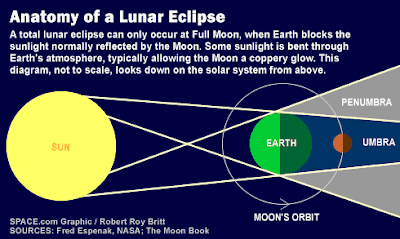What
is an eclipse?
When the
Earth, moon and sun are all perfectly aligned, observers on Earth may be able to
witness an eclipse. There are two main types of eclipses; lunar eclipses and
solar eclipses.
A lunar
eclipse occurs when the Earth lies between the sun and the Moon, and the Earth's
shadow falls on the Moon. Anyone on the side of the Earth that faces the Moon at
that time can see such an eclipse. If only the outer part of Earth's shadow
croses the Moon, then a partial eclipse is seen; if the central part of the
shadow covers the Moon, the result is a total eclipse.
A solar
eclipse occurs when the Moon lies between the sun and the Earth, and blocks the
view of the sun. If the Moon only partially blocks the sun then this causes a
partial eclipse; if the Moon completely coves the sun, the result is a total
eclipse.
Diagram 1 The Ecplise of the Moon
2.Sometimes, the Earth, the Moon and the Sun are in a straight line.
3.The eclipse of the Moon happens when the Earth is between the Moon and the Sun in a
straight line.
straight line.
4. During the eclipse of the Moon,
(a) the sunlight is blocked by the Earth from reaching the Moon.
(b) so, the Earth forms its shadow on the Moon and couses the Moon appear darker.
(c) we can see the Earth's shadow on the side of the Earth that is experiencing night-time.
(d) we can see the eclipse of the Moon with the naked eye.
5. The Earth forms two types of shadow on the Moon:
(a) the lighter shadow
(b) the dark shaodow
6. When the Moon is the lighter shadow of the Earth, a partial eclipse of the Moon
happens.
happens.
7.When the Moon is in the dark shadow of the shadow of the Earth, a total eclipse of the Moon happens.
The Darkening Sun
1. The eclipse of the Sun happens when the Moon is between the Earth and Sun in a straight line.
Diagram 2 The Eclipse of the Sun
2. During the eclipse of the Sun,
(a) the sunlight is blocked by the Moon from reaching the Earth.
(b) so, the Moon forms its shadow on the Earth.
(c) we see less of the Sun because it is covered by the Moon.
3. When the Sun is totally covered of the by the Moon, a total eclipse of the Sun happens.
4. During the total eclipse of the Sun , we see a bright ring called corona that surrounds the
Moon.
Moon.
5. When the Sun is partly covered by the Moon, a partial eclipse of the Sun happens.

Diagram 3 Total eclipse and partial eclipse of the Sun
6. Diagram 3,
(a) we can see the eclipse of the Sun when standing at positions 1, and 2 on the Earth.
(b) the sun is partly blocked by the Moon at position 1,2.
(c) so, we can see the Sun appearing on the sides of the Moon. This is called partial eclipse
of the Sun.
(d) the Sun is fully blocked by the Moon at position 2. This is called total eclipse of the Sun.
7. The eclipse of the Sun only happens a few minutes in daytime.
8. During the eclipse of the Sun, the sky gets darker until eventually becomes like night-
time.
9. The Earth also becomes cooler during the eclipse of the Sun.
10.We should not look directly at the Sun during the eclipse of the Sun because the bright
sunlight may damage our eyes.
8. During the eclipse of the Sun, the sky gets darker until eventually becomes like night-
time.
9. The Earth also becomes cooler during the eclipse of the Sun.
10.We should not look directly at the Sun during the eclipse of the Sun because the bright
sunlight may damage our eyes.
Diagram 4 Solar Eclipses: Partial or complete obscuration of Sun by Moon



Well done!
ReplyDeleteTQ
Deleteso nice~~Keep it up!~~TQ
ReplyDeleteThank You!~
ReplyDelete